Shanghai World Financial Center
| Shanghai World Financial Center | |
|---|---|
| 上海环球金融中心 | |
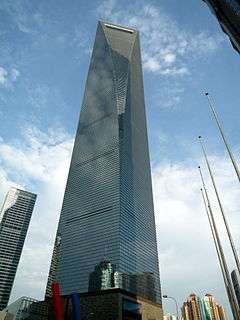 The Shanghai World Financial Center in July 2010 | |
| General information | |
| Status | Complete |
| Type | Office, hotel, museum, observation, parking garage, retail |
| Architectural style | Neo-Futurism |
| Location | 100 Century Avenue, Pudong, Shanghai, China |
| Coordinates | 31°14′12″N 121°30′10″E / 31.23667°N 121.50278°ECoordinates: 31°14′12″N 121°30′10″E / 31.23667°N 121.50278°E |
| Construction started | 27 August 1997 |
| Completed | 2008 |
| Opening | 28 August 2008 |
| Cost |
RMB ¥ 8.17 billion (USD $ 1.20 billion) |
| Owner | Shanghai World Financial Center Co., Ltd. |
| Height | |
| Architectural | 492.0 m (1,614.2 ft) |
| Tip | 494.3 m (1,621.7 ft) |
| Roof | 487.4 m (1,599.1 ft) |
| Top floor | 474.0 m (1,555.1 ft) |
| Observatory | 474 m (1,555.1 ft) |
| Technical details | |
| Floor count | 101 (3 below ground) |
| Floor area | 381,600 m2 (4,107,500 sq ft) |
| Lifts/elevators | 91 |
| Design and construction | |
| Architect | Kohn Pedersen Fox |
| Developer | Mori Building Co. |
| Structural engineer | Leslie E. Robertson Associates RLLP |
| Main contractor | China State Construction Engineering Corp and Shanghai Construction (Group) General Co. |
| References | |
| [1][2][3][4] | |
The Shanghai World Financial Center (SWFC; Chinese: 上海环球金融中心) is a supertall skyscraper located in the Pudong district of Shanghai, China. It was designed by Kohn Pedersen Fox and developed by the Mori Building Company, with Leslie E. Robertson Associates as its structural engineer and China State Construction Engineering Corp and Shanghai Construction (Group) General Co. as its main contractor. It is a mixed-use skyscraper, consisting of offices, hotels, conference rooms, observation decks, and ground-floor shopping malls. Park Hyatt Shanghai is the tower's hotel component, comprising 174 rooms and suites occupying the 79th to the 93rd floors, which at the time of completion was the highest hotel in the world. It is now the third-highest hotel in the world after the Ritz-Carlton, Hong Kong, which occupies floors 102 to 108 of the International Commerce Centre.[5]
On 14 September 2007, the skyscraper was topped out and is 492 metres (1,614.2 ft),[1][3] making it the 8th tallest building in the world and the fourth tallest structure in Mainland China. The SWFC opened to the public on 28 August 2008, with its observation deck opening on 30 August. The observation deck offers views from 474 m (1,555 ft) above ground level.[6]
The SWFC has been lauded for its design, and in 2008 it was named by architects as the year's best completed skyscraper.[7][8] In 2013, the SWFC was exceeded in height by the adjacent Shanghai Tower,[9] which is China's tallest structure as of 2016. Together, the Shanghai World Financial Center, Shanghai Tower and Jin Mao Tower form the world's first adjacent grouping of three supertall skyscrapers.
History
Designed by American architectural firm Kohn Pedersen Fox, the 101-storey tower was originally planned for construction in 1997, but work was temporarily interrupted by the Asian Financial Crisis in the late 1990s, and was later paused to accommodate design changes by the Mori Building Company. The building of the tower was financed by several multinational firms, including Chinese, Japanese, and Hong Kong banks, as well as by the Japanese developer and American and European investors. The American investment bank Morgan Stanley coordinated the tower's financing for Mori Building.
Construction
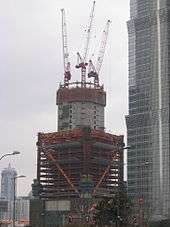
The tower's foundation stone was laid on 27 August 1997. In the late 1990s, the Pierre de Smet Building Corporation suffered a funding shortage caused by the Asian financial crisis of 1997–98, which halted the project after the foundations were completed. On 13 February 2003, the Mori Group increased the building's height to 492 m (1,614 ft) and 101 storeys, from the initial plans for a 460-metre (1,509 ft), 94-storey building. The new building used the foundations of the original design, and construction work was resumed on 16 November 2003.[10]
A fire broke out in the incomplete SWFC on 14 August 2007. The fire was first noticed on the 40th floor, around 16:30 (GMT +8), and soon the smoke was clearly seen outside the building. By 17:45, the fire had been extinguished. The damage was reported to be slight, and nobody was injured in the accident.[11] The cause of the fire remains unknown, but according to some sources the preliminary investigation suggested workers' electric weldings caused the fire.[12][13]
The building reached its full height of 492 m (1,614 ft) on 14 September 2007 after the installation of the final steel girder.[14] The final cladding panels were installed in mid-June 2008, and elevator installation was finished in mid-July. The Shanghai World Financial Center was declared complete on 17 July 2008, and was officially opened on 28 August.[6] On 30 August 2008, the tower's observation floors were opened to the public.
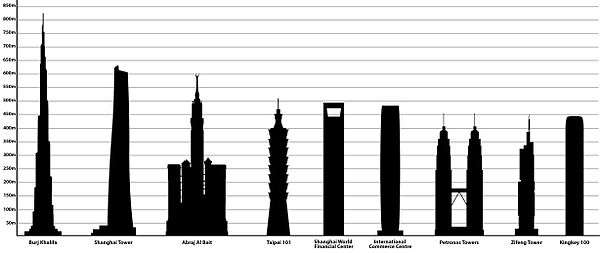
Architecture

| Shanghai World Financial Center | |||||||||||||||
| Simplified Chinese |
上海环球 金融中心 | ||||||||||||||
|---|---|---|---|---|---|---|---|---|---|---|---|---|---|---|---|
| Traditional Chinese |
上海環球 金融中心 | ||||||||||||||
| |||||||||||||||
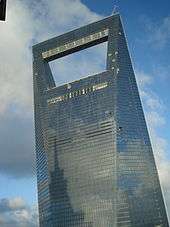
The most distinctive feature of the SWFC's design is the trapezoid aperture at the peak. The original design specified a circular aperture, 46 m (151 ft) in diameter, to reduce the stresses of wind pressure[15] and to reference the Chinese mythological depiction of the sky as a circle.[15] It also resembled a Chinese moon gate due to its circular form in Chinese architecture. However, this initial design began facing protests from some Chinese, including the mayor of Shanghai, Chen Liangyu, who considered it too similar to the rising sun design of the Japanese flag. Pedersen then suggested that a bridge be placed at the bottom of the aperture to make it less circular.[3] On 18 October 2005, KPF submitted an alternative design to Mori Building and a trapezoidal hole replaced the circle at the top of the tower, which in addition to changing the controversial design, would also be cheaper and easier to implement, according to the architects.[3][16] Foreigners and Chinese alike informally refer to the building as "the bottle opener".[17] Metal replicas of the building that function as actual bottle openers are sold in the tower's gift shop.
The tower features three separate observation decks which constitute the floors above and below the aperture opening. The height of the lowest observation deck, located on the 94th floor, is 423 m (1,388 ft); the second, on the 97th floor, is at a height of 439 m (1,440 ft); and the highest, on the 100th floor, is 474 m (1,555 ft) high.
The skyscraper's roof height is set at 492 metres (1,614 ft), and was at one point the highest roof in the world. Before construction on the roof was completed, the SWFC's total height was scheduled to be 509.2 m (1,671 ft) so that it would exceed the height of the Taipei 101, but a height limit was imposed, allowing the roof to reach a maximum height of 492 metres. Architect William Pedersen and developer Minoru Mori resisted suggestions to add a spire that would surpass that of Taipei 101 and perhaps One World Trade Center, calling the SWFC a "broad-shouldered building". The SWFC boasts a gross floor area of more than 377,300 m2 (4,061,200 sq ft), 31 elevators, and 33 escalators.
Structural efficiency
The tower's trapezoid aperture is made up of structural steel and reinforced concrete. A large number of forces, such as wind loads, the people in the building and heavy equipment housed in the building, act on the SWFC's structure. These compressive and bending forces are carried down to the ground by the diagonal-braced frame (with added outrigger trusses). The design employs an effective use of material, because it decreases the thickness of the outer core shear walls and the weight of the structural steel in the perimeter walls.[7]
Tenants
Shanghai World Financial Center hosts the office building for many international financial companies, including Banking, insurance, securities and fund management, such as Ernst & Young, Morgan Stanley, BNP Paribas, Commerzbank, Bank of Yokohama, Sumitomo Mitsui Banking Corporation and Korea Development Bank.[18][19] Google's Shanghai branch also is located here,[20]on the 60th floor.[21]
Transport
- Shanghai Metro: Line 2 at Lujiazui Station, then take a 10-minute walk.[22]
Awards
Shanghai World Financial Center was named by architects as the best skyscraper completed in 2008, receiving both the Best Tall Building Overall and Asia & Australasia awards from the Council on Tall Buildings and Urban Habitat (CTBUH).[7][23] CTBUH's Carol Willis, head of New York's Skyscraper Museum, stated: "The simplicity of its form as well as its size dramatizes the idea of the skyscraper."[7] Architect Tim Johnson noted its innovative structural design: "Steel trusses guard against the forces of wind and earthquake and made the building lighter, made it use less steel, and contributed to its sustainability."[7] Johnson described the SWFC's structure as "nothing short of genius."[23]
Gallery
-

Shanghai World Financial Center, visible behind the Oriental Pearl Tower.
-

Inside the tower's observation deck.
-

Shanghai World Financial Center (left) and the Jin Mao Tower.
-

The Shanghai World Financial Center and Jin Mao Tower adjacent to each other.
-

At night.
-
Next to the Jin Mao Tower.
-

Beside the Shanghai Tower at night.
-

Under construction.
-
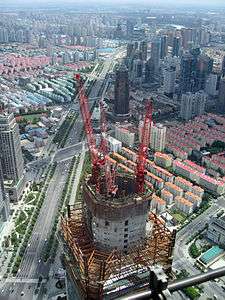
Under construction.
-
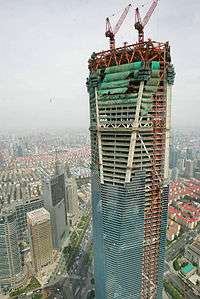
Under construction.
-

Beside Jin Mao Tower.
-
Shanghai World Financial Center pictured at night.
-

The aperture under construction at the top of the building.
-
Stucco mural depicting the original design.
-

Pamphlet issued at tower in 2008.
-

The SWFC, Jin Mao Tower and incomplete Shanghai Tower (far right) in August 2012.
-
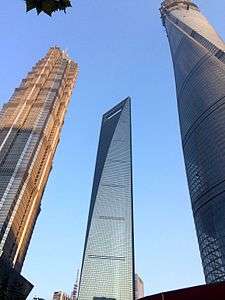
The SWFC, Jin Mao Tower, and the Shanghai Tower near completion in January 2014.
-
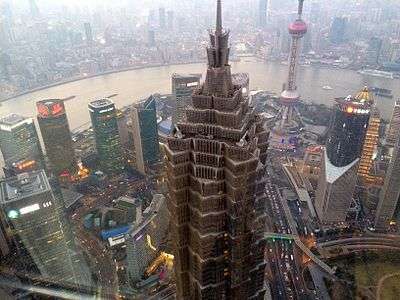
View of Jin Mao Tower from the SWFC observation deck.
-
.jpg)
Top of the building.
-
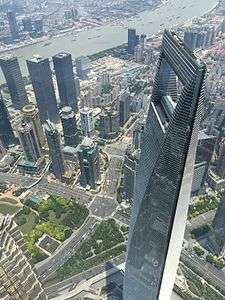
Shanghai World Financial Tower seen from Shanghai Tower, 2016.
See also
- List of tallest buildings in Shanghai
- Ping An Finance Centre
- KL118
- India Tower
- Suzhou Zhongnan Center
- Goldin Finance 117
- Baoneng Shenyang Global Financial Center
- Gezhouba International Plaza
- China Zun
- CTF Finance Centre
- Bottle opener
References
- 1 2 "Shanghai World Financial Center – The Skyscraper Center". Council on Tall Buildings and Urban Habitat. Retrieved 5 August 2013.
- ↑ "Shanghai World Financial Center". SkyscraperPage.com. Retrieved 10 April 2008.
- 1 2 3 4 "Shanghai World Financial Center". Emporis. 2008. Retrieved 2 February 2013.
- ↑ "Shanghai tops out world's third-tallest building". China Daily. 15 September 2007. Retrieved 5 August 2013.
- ↑ "Park Hyatt Shanghai To Open In 2008". China Hospitality News. 19 November 2007. Retrieved 5 August 2013.
- 1 2 "China's tallest and timely arrival". BBC. 28 August 2008. Retrieved 5 August 2013.
- 1 2 3 4 5 "Shanghai tower named year's best skyscraper". Reuters. 20 November 2008. Retrieved 5 August 2013.
- ↑ "Shanghai tower named year's best skyscraper". ABS-CBN News. 21 November 2008. Retrieved 5 August 2013.
- ↑ "Shanghai Tower Construction Continues Despite Rumors of salt in concrete sand". NextBigFuture.com. 25 April 2013. Retrieved 20 May 2013.
- ↑ "Construction of Shanghai World Financial Center resumes". People's Daily Online. 18 November 2005. Retrieved 22 May 2008.
- ↑ "Fire breaks out at troubled Shanghai World Financial Center". Forbes. AFX News Limited. 14 August 2007. Retrieved 22 May 2008.
- ↑ Ying, Gao (15 August 2007). "Shanghai World Financial Center catches fire". Xinhua News Agency. Retrieved 22 May 2008.
- ↑ Fei, Xing (14 August 2007). "China's Tallest Building Catches Fire". The Epoch Times. Retrieved 22 May 2008.
- ↑ "China's tallest building rises". The Guardian. 14 September 2007. Retrieved 22 May 2008. (The video has been removed due to expiry of the copyright).
- 1 2 Lubow, Arthur (21 May 2006). "The China Syndrome". The New York Times. Retrieved 22 May 2008.
- ↑ "Shanghai World Financial Center (facts)". Emporis.com. Retrieved 29 November 2012.
- ↑ "'Bottle opener' or spire of serenity?". Shanghai Daily (subscription required). Retrieved 29 November 2012.
- ↑ deVry, Erica (18 August 2010). "Ernst & Young Relocates to Shanghai World Financial Center, Tallest Building in China". Big4.com. Retrieved 3 January 2016.
- ↑ "上海环球金融中心租掉了大半". 21世纪经济报道. December 18, 2009. Retrieved 3 January 2016.
- ↑ "探访Google上海环球金融中心办公室". 中国IDC圈. 26 April 2012. Retrieved 3 January 2016.
- ↑ "Google locations." Google. Retrieved on May 25, 2016. "Google Shanghai 60F, Shanghai World Financial Center 100 Century Avenue, Pudong New Area Shanghai 200120, China"
- ↑ "SWFC Observation Deck". smartshanghai.com. Retrieved 3 January 2016.
- 1 2 "CTBUH 2008 Awards". Council on Tall Buildings and Urban Habitat. Retrieved 28 April 2012.
External links
| Wikimedia Commons has media related to Shanghai World Financial Center. |
- Shanghai WFC official website(Chinese)(English)(Japanese)
- Shanghai World Financial Center observatory(Chinese)(English)(Japanese)
- Kohn Pedersen Fox Shanghai WFC project page
- Mori Building Co. Shanghai WFC project page
- Shanghai WFC on CTBUH's Skyscraper Center database
- The Shanghai WFC: a case study on Constructalia
- Emporis.com data page on the Shanghai WFC
- Window cleaners at work on the Shanghai WFC (video from the observation deck)
| Records | ||
|---|---|---|
| Preceded by Jin Mao Tower |
Tallest building in China 487.4 m (1,599.1 ft) 2007–2013 |
Succeeded by Shanghai Tower |
| Preceded by Jin Mao Tower |
Tallest building in Shanghai 2007–2013 |
Succeeded by Shanghai Tower |
| Preceded by Taipei 101 |
World's highest roof 487.4 m (1,599.1 ft) 2008–2010 |
Succeeded by Burj Khalifa |
